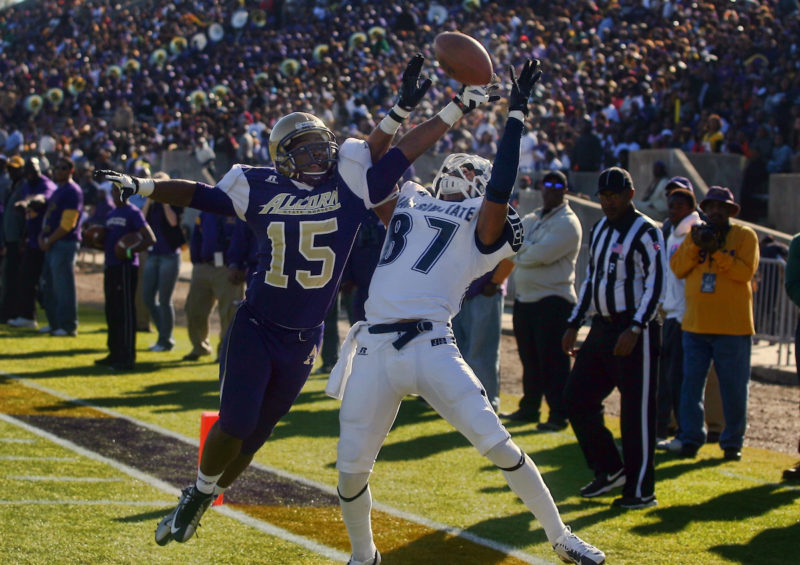Here at PhotoShelter, we love working with university photographers. They cover a wide range of subjects (from basketball to marine biology), pump out incredible images at a grueling pace, and constantly take their work to the next level – because on a college campus, you’re always learning and innovating.
Every year, we support the University Photographers’ Association of America (UPAA) Symposium, which brings together campus photographers from across the country. At this year’s event, we recognized Jackson State University photographer Charles Smith with our UPAA Grant Award. His incredible work speaks for itself, but we couldn’t help asking him some behind the scenes questions.
Check out our Q&A with Charles below, and follow along with his work on Instagram @charlesanthonysmith and @jacksonstateu!
What’s a cool project you’ve been working on – personally or professionally? Tell us how it came about, why it matters to you, and how you hope it will move your audience.
Over the last year or so, I’ve been working on a series of portraits and candid shots of people living in west Jackson. I was interested in exploring the changing demographics around the university in which I am employed. What I’ve seen over the last decade is a mass exodus of black middle class families moving to suburban communities. I wanted to get a better feel of the remaining people who live in the community that I grew up in. This area of the city has all the issues of urban strife… high crime rates, deteriorating schools and lowering home ownership. In the midst of these challenges I see a wide range of people from varying levels of education, and economic status. My goal is to let people know we are more than negative statistics and negative 6pm news stories.
What’s your #1 workflow tip / lesson learned / insight you wish you had known when you were first getting started?
Metadata, metadata, metadata… I’ve worked on really grasping the importance of developing and implementing metadata keywords for images that we produce. When you are a one-person photo department it is easy to not pay attention to the importance of creating and managing this process. My #1 tip is to create solid metadata keywords and be sure that your external users have a good understanding of the process and be comfortable with taking suggestions from your external and internal end users of your digital assets. Sometimes they have insights on things you may be looking over.
How has video changed your job? What impact has it had?
I’ve been shooting for quite a while and I’ve worked through the transition of film to digital and the expansion of still photographers dabbling in video. My transition has been easier because our social media team is primarily responsible for video production on our campus. However, I’ve spent a year in developing stronger video production skills. What I’ve learned is simple b-roll is everything. Shoot with movement to advance your story.
Share the backstory of one of your favorite images. What makes it special / why are you proud of it? We want to know everything from why you took the image, to the gear you used, to how it moved your audience. Let us see your passion!
I’ve always been a huge fan of Sports Illustrated photographers Neil Leifer and Walter Iooss, Jr. I idolized them as a kid. I fantasized about shooting for SI, my local newspaper and anyone who would publish my work. Those guys were my superheroes and I wanted to be just like them. During my journey as a photojournalist I’ve had wonderful opportunities and I’ve been published in some cool publications but I never really had the opportunity to do what I call a Walter Iooss, Jr. inspired image.
That opportunity arose this past spring when I was assigned to shoot the Jackson State men’s and women’s teams headshots for the athletic department’s website. One of our student athletes asked if I could do some personal promo shots to send to his family in Africa while shooting their headshots.
We came up with the idea to shoot them with a racket with the strings cut out and their faces peering through. I wanted to add drama to the images so I decided to use a ring light so that their eyes would just pop off the page. I shot the image with a Canon 1Dx and a Sigma 24-70 at 2.8 and 1/500th of a second. I eventually entered one of the images in the UPAA monthly competition and was awarded 1st in the sports illustration division. I am pretty proud of that because my peers in the industry really liked what I did. We also shared the image with our audience on the JSU social media platforms and our alumni and supporters loved it as well.
There have been so many changes in the world of photography in that last 20 years. Where do you see photography – and the role of a university photographer – in say 5,10, 15 years?
Photography is ever evolving and changing for sure. There are things that are universal and will always be with us no matter the time or era; that is the storytelling component. However, what has democratized photography is technology. Because of the role of the smart phone and cheaper equipment costs more people have access to making images than ever before. The only thing that separates professionals and amateurs is imagination and the ability to tell a story. University photographers have to keep up with the trends. I think it is important that we embrace new technology because we are at the forefront of youth culture. Thriving in this era is all about being aware of what is the “it” thing and finding a way to implement parts of “it’ into your daily process.
Up Next: Developing a Visual Storytelling Strategy for Schools and Universities



